 NRx (formerly known as Net Results Express) is UHN's monthly research e-newsletter. Every year, the December issue of NRx is dedicated to highlighting the previous year’s research achievements of UHN's five research institutes, the Princess Margaret Cancer Centre, the Toronto General Research Institute (TGRI), the Toronto Western Research Institute (TWRI), the Toronto Rehabilitation Institute (TRI) and the Techna Institute (Techna).
NRx (formerly known as Net Results Express) is UHN's monthly research e-newsletter. Every year, the December issue of NRx is dedicated to highlighting the previous year’s research achievements of UHN's five research institutes, the Princess Margaret Cancer Centre, the Toronto General Research Institute (TGRI), the Toronto Western Research Institute (TWRI), the Toronto Rehabilitation Institute (TRI) and the Techna Institute (Techna).
In this issue you can read about:
-
DISCOVERY—UHN researchers developed new treatments for hepatitis C and stroke; and they shed further light on the mechanisms underlying cancer, diabetes, arthritis and the resistance of certain blood cancers to chemotherapy.
-
PEOPLE—UHN announced the appointment of Dr. Peter Pisters, who will join us as President and CEO in January 2015.
-
SUPPORT—Funding from CFI and other organizations will enable UHN researchers to continue their groundbreaking research in the fields of cancer, spinal cord injury, diabetes, cardiovascular disease, and degenerative disorders of the brain and eye.
-
DISTINCTION—UHN scientists were honoured for their acheivements in research.
We hope you will find this newsletter informative and helpful. If you have feedback or questions, please contact www@uhnresearch.ca.
Happy holidays.
Christopher J. Paige, PhD, FCAHS
Vice President, Research
University Health Network
Lung Cancer: Smoking Out the Factors That Prevent Quitting

One's ability to quit smoking can be influenced by nicotine dependence, social support and exposure to second-hand smoke.
While the ability to quit smoking is strongly influenced by social pressures, it is unclear to what extent this is true for those recently diagnosed with lung cancer. PM researchers Drs. Geoffrey Liu and Wei Xu found that people who were recently diagnosed with lung cancer were less likely to quit smoking if they were exposed to second-hand smoke, particularly if the exposure originated from the home or from a spouse who smokes. This study emphasizes the importance of considering psychosocial factors in the development of new strategies to improve smoking cessation success, particularly because people who continue to smoke after lung cancer diagnosis suffer worse outcomes. [Pubmed abstract]
Diabetes: Leptin in Gut Lowers Blood Sugar

According to the World Health Organization, 347 million people worldwide have diabetes.
Abnormally high blood sugar levels can damage tissues and are a defining symptom of diabetes. As such, the amount of glucose—a sugar that is an important source of energy—circulating in the blood is tightly controlled by several hormones. TGRI Senior Scientist Dr. Tony Lam discovered that the hormone leptin activates cells in a particular region of the gut (the jejunum) to lower blood sugar. This study helps explain the anti-diabetic effect of duodenal-jejunal bypass, a surgical procedure used to treat diabetes and obesity, and represents a viable new therapeutic target to lower blood sugar levels in these disorders. [Pubmed abstract]
Leukemia: Tracing the Earliest Steps of Disease
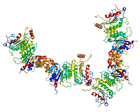
Mutations in a protein known as DNMT3a (pictured above) may be present in healthy adults and pre-date AML diagnosis by months or even years.
When certain mutations arise in hematopoietic stems cells (HSCs)—cells in the bone marrow that give rise to all blood cells—blood cancers like acute myeloid leukemia (AML) can develop. The series of events that connect early mutations to the eventual development of AML have not been fully defined. McEwen Researcher Dr. John Dick discovered that some AML patients had a specific population of HSCs that did not carry mutations normally found in leukemia, yet had a mutation in the DNMT3a gene—identifying them as pre-leukemic ancestors of AML. The pre-leukemic cells were able to survive chemotherapy and were present in patients in remission. These findings will help develop early detection and treatment approaches that target mutated pre-leukemic cells, and may provide new ways to monitor disease status in patients in remission. [Pubmed abstract]
Cancer: Earlier Palliative Care Benefits Patients

Palliative care addresses the psychological, physical and spiritual needs of patients with life-threatening illness and their family members.
Terminally ill patients typically receive palliative care, which is designed to alleviate their suffering and improve their quality of life. PM Scientist Dr. Camilla Zimmermann led a study in which terminally ill cancer patients received either standard palliative care (ie, in the last two months of life) or early palliative care, including monthly consultations with a physician and nurse who provided specialized care and support. After four months, patients that received earlier palliative care had significant improvements in their quality of life, ability to cope with their symptoms and satisfaction with care, compared to those receiving standard care. This study offers evidence to improve the wellbeing of these patients by changing how and when palliative care is delivered. [Pubmed abstract]
Radiation Therapy: Modelling Changes in Tumour Geometry
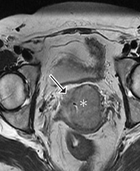
MR images can help to accurately measure the size of a cervical tumour, like the one above. With computer modelling of shape changes, fewer scans may be needed.
Radiation therapy directs radiation beams at a tumour, leading to cell death and tumour shrinkage. It requires a careful balance of targeting the tumour while minimizing exposure to the healthy tissues around it; this is complicated by the fact that tumours change size during the course of treatment. To address this, Techna Affiliated Faculty Dr. Mohammad Islam developed a computer model that simulates tumour shrinkage in cervical cancer. The simulation can predict changes in tumour volume, allowing for modifications in radiation delivery to be planned in advance. It also helps to reduce the cost of frequent imaging to confirm reductions in tumour size. Adapting the treatment delivery to the changing shape of the tumour will lead to better outcomes for patients by making the therapy more specific. [Pubmed abstract]
Rehabilitation: Brain Imaging as a Predictor of Physical Fitness
TRI Affiliate Scientist Dr. Krista Lanctôt uncovered new associations between physical fitness and brain structure by using magnetic resonance imaging (MRI). Brain MRI data from patients with coronary artery disease (CAD) were compared to their own measurements after 6 months of physical training. The study revealed that cardiovascular fitness was strongly associated with an increase in blood flow to the brain. Fitness was also correlated with positive changes in specific regions of the brain involved in memory, motor learning and reward. The study demonstrates that MRI scans could potentially be used to monitor changes in physical fitness, and help to identify which patients with CAD are benefiting most from exercise-based cardiac rehabilitation. [Pubmed abstract]
Cancer: Cost Effectiveness of Personalized Medicine
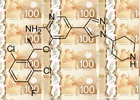
Crizotinib increased survival in lung cancer clinical trials, but costs for the treatment were $7,000 CAD per three-week cycle.
With our improved understanding of the genetic component of cancer, genomic testing can identify those patients who are most likely to benefit from receiving drugs that target mutations that are unique to their cancer. PM Clinical Researcher Dr. Natasha Leighl led a study examining the costs and benefits associated with crizotinib—a drug that targets a form of lung cancer with a specific genomic profile (EML-4 ALK rearrangement). The researchers estimated that the drug would cost over $250,000 per year of productive life saved. Even after factoring rigorous cost-saving strategies, this was not considered cost effective by the Canadian public health care system. Health economics studies such as this one help provide an objective basis for deciding which new medications the province can afford to pay for. [Pubmed abstract]
Liver Disease: A Breakthrough for Hepatitis C

This new therapeutic regimen comprises five different medications that prevent the virus from multiplying within the liver.
Over 180 million people worldwide are infected with the hepatitis C virus (HCV). HCV causes progressive liver damage that can lead to liver failure or liver cancer. The current treatment regimen can cause serious side effects and has a relatively low cure rate. TGRI Scientist Dr. Jordan Feld led a study investigating a new therapeutic regimen to treat HCV infections. The new regimen led to higher cure rates than conventional HCV treatments and caused significantly fewer side effects, enabling more patients to complete their treatment. This new therapeutic regimen has the potential to save lives by decreasing the prevalence of HCV and its associated complications. [Pubmed abstract]
Diabetes: Key Regulator of Insulin Secretion Identified
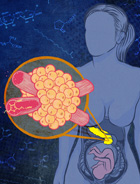
Approximately 3-14% of all women will develop gestational diabetes during pregnancy.
Some women develop gestational diabetes during pregnancy, in which they are unable to produce sufficient levels of insulin to control their blood sugar levels. This type of diabetes often precedes the development of type 2 diabetes later in life. A study led by TGRI Senior Scientist Dr. Michael Wheeler addresses this health concern by identifying a metabolite—a small molecule produced in the body called CMPF—that may indicate risk of developing gestational diabetes. Patients with gestational or type 2 diabetes had higher CMPF levels than non-diabetic patients. CMPF inhibited insulin production and release, whereas blockage of CMPF activity restored insulin secretion levels. The metabolite is thus a promising novel target for the prevention and treatment of gestational and type 2 diabetes. [Pubmed abstract]
Cancer: A Carrier Particle for Image-Guided Drug Delivery

A specific receptor on many cancer cells ushers in the HPPS nanoparticle and its therapeutic payload, like Trojans welcoming the mythical horse.
RNA interference is a powerful technique for fighting cancer that can selectively block the actions of disease-related genes. However, turning RNA interference technology into a viable treatment is a significant challenge as the active component—silencing RNA (siRNA)—is rapidly degraded and removed from the bloodstream after injection. PM Senior Scientist and Techna Team Lead Dr. Gang Zheng created a small carrier molecule known as HPPS that serves as a Trojan horse to protect and transport the siRNA through the bloodstream to the tumour. HPPS is non-toxic, has the ability to be tracked in the body and delivers effective doses of siRNA to cancer cells. Nanoparticles like this, with diagnostic imaging and therapeutic capabilities, will help clinicians optimize treatment plans and dosages. [Pubmed abstract]
Parkinson's Disease: Brain Structures Provide Clues to Cognitive Function
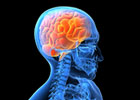
Parkinson's disease affects the dopamine-producing neurons in the brain, which leads to increased muscle rigidity, tremors and motor instability.
A study by TWRI Senior Scientist Dr. Antonio Strafella provided evidence that changes in brain structure can be used to provide detailed measurements of the cognitive impairments (losses of reasoning, logic and memory) that occur in patients with Parkinson's disease. Using magnetic resonance imaging brain scans, the researchers found that Parkinson's disease patients had subtle changes in structure within regions of the brain involved in cognition and in linking sensory and motor functions compared with normal subjects. Not surprisingly, changes to brain structures within these regions related directly with brain function. Imaging these structures may provide highly sensitive measurements that could be used, for example, to gauge patient responses to new treatments for Parkinson's disease. [Pubmed abstract]
Type 2 Diabetes: Nervous System Key to Prevention

While a high-fat diet is a risk factor for developing type 2 diabetes, the underlying driver of disease may be inflammation.
Inflammation plays an important role in the development of type 2 diabetes, with blood cells called macrophages driving the process. Recent research has demonstrated that signals from the nervous system can dramatically change the behaviour of the macrophages. TGRI Scientist Dr. Minna Woo investigated whether manipulating the nerves within an anti-inflammatory pathway could influence the development of type 2 diabetes. Increasing the activity of these neurons caused inflammatory cells known as macrophages to switch towards a desired, anti-inflammatory state. In an experimental model that involved a high fat diet, this simple change completely eliminated the onset of type 2 diabetes. Pushing macrophages towards this anti-inflammatory state may represent a powerful new strategy for preventing and treating type 2 diabetes. [Pubmed abstract]
Obesity and Depression: Two Sides of the Same Coin?

Body weight may influence the body's ability to respond to antidepressant drugs.
Depression is often associated with obesity. Previous studies have examined whether a person's body mass index (BMI)—a measure of body weight relative to body length—is able to predict response to antidepressant therapies, but have failed to provide conclusive results. A limitation of these studies is that BMI data were grouped into broad categories (eg, normal, overweight or obese), thus potentially concealing subtle differences. Dr. Roger McIntyre, Clinical Researcher at TWRI, used a more direct approach. Rather than grouping patients into categories, he simply examined the relationship between BMI and response to antidepressant therapy in people with depression. This approach revealed that people with higher BMIs responded worse to the antidepressants. This study highlights that categorizing BMI data may result in loss of information and explain the inconsistent results seen in the past. [Pubmed abstract]
HIV: Hormone Linked to Low Birth Weights

Without treatment, the risk of HIV transmission from a breastfeeding mother to her child is estimated to be between 20 and 45%.
The transmission of human immunodeficiency virus (HIV) from a pregnant woman to the fetus can be prevented by treating mothers with combination antiretroviral therapy (cART). However, treatment with a certain type of cART, PI-cART, is associated with premature delivery and low birth weight. TGRI Scientist, Dr. Lena Serghides revealed that progesterone—a hormone important to normal births—may be involved in this association. She found that HIV-infected pregnant women treated with PI-cART had lower progesterone levels in comparison to those treated with another cART or those who were not infected with HIV. In an experimental model, supplementing pregnant mothers with progesterone improved birth weights. This can translate into more informed treatment choices for HIV-positive pregnant women and new ways to protect the health of their children. [Pubmed abstract]
Motion Sickness: What You Hear Matters
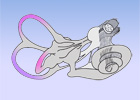
The vestibular system, part of the inner ear (pictured), comprises three semicircular canals (in purple) that enable motion and balance to be perceived in three dimensions.
Simulator sickness is a condition related to motion sickness that can occur when using gaming and virtual reality systems. It is said to be caused visually because the condition occurs in the absence of physical movement; however, little is known about whether simulated sounds contribute to this condition. To explore this, TRI Scientist Dr. Jennifer Campos led a study in which participants were placed in an immersive virtual reality dome and exposed to a series of visual or audio cues. As expected, visual cues induced simulator sickness, but 25% of participants also experienced the condition when exposed to sound alone. This study will help to design better simulation technologies to minimize the effects of this new type of motion sickness—one caused purely by sound. [Pubmed abstract]
Sleep Apnea: Passively Measuring Fluid Accumulation with Sound
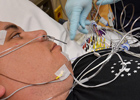
Traditional sleep studies measure obstructive sleep apnea treatments using several pieces of equipment and many electrodes.
Obstructive sleep apnea is a common condition where the upper airway becomes periodically blocked during sleep, causing short pauses in breathing. The accumulation of fluid in the neck appears to play a role in this disorder. TRI Scientist Dr. Azadeh Yadollahi developed a convenient and non-invasive technique to measure fluid accumulation in the neck and monitor the severity of sleep apnea. The technique uses changes in breathing sounds and vibrations in the tissue to estimate the fluid volume changes. This reliable and convenient screening technique offers an invaluable tool with which we can evaluate the efficacy of future potential treatments for obstructive sleep apnea. [Pubmed abstract]
Cancer: Fertile Ground for Growth

Tumour growth is often likened to a "seed" (cancer cells) growing in "soil" (normal tissue environment). Loss of TIMPs in the soil promotes growth of the seed.
Tumour growth and metastasis are partially dependent on its complex interactions with the surrounding normal tissue ("stroma"). PM Senior Scientist Dr. Rama Khokha identified the TIMP family of proteins in the stroma as important regulators for restricting tumour growth. The loss of TIMPs changed normal cells in the stroma into cancer-associated fibroblast (CAF) cells. CAFs released "exosomes"—encapsulated cellular components—that interacted with tumour cells and helped them grow. Loss of TIMPs also enhanced the activity of enzymes within these exosomes to promote cancer growth and metastasis. This study has revealed clues to the consequences of TIMP loss in cancer, and suggests that restoration of TIMP function in the tissue surrounding cancer may restrict tumour growth. [Pubmed abstract]
Lupus: New Way to Monitor Symptom Flares

The highly varied symptoms of lupus (also known as systemic lupus erythematosus) include joint pain, fever, light sensitivity, fatigue, hair loss and skin conditions.
Lupus is a condition in which the body's immune system attacks multiple organs. Although blood tests exist to diagnose lupus, they do not always provide reliable readouts of disease activity. Researchers including TWRI Principal Investigator Dr. Carolina Landolt-Marticorena and Senior Scientist Dr. Joan Wither are searching for other molecules (ie, biomarkers) that better predict disease state. Their study that found that immune molecules in the blood, known as anti-nucleosome antibodies, out-performed traditional biomarkers and were better able to predict the severity of lupus symptoms over time in individual patients. The study reveals a new tool that may mirror changes in disease activity over time, and serve as a personalized readout of disease. [Pubmed abstract]
Psoriatic Arthritis: Improving Early Detection
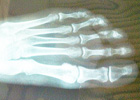
There is currently no widely accepted diagnostic test for psoriatic arthritis; rather, it is diagnosed using various methods, including x-rays (pictured above) and physical examinations.
People with psoriasis—an immune-mediated skin condition—are at risk for developing a related condition called psoriatic arthritis (PsA). PsA is a form of arthritis that involves inflammation in the bone, fingers and spine, and its development has a genetic component. TWRI Senior Scientist Dr. Dafna Gladman compared the levels of thousands of genes present in blood samples from people with psoriasis alone with those from people with PsA. Similar genes were involved in both conditions, but five of them may serve as robust readouts (biomarkers) that could be used to predict which patients develop PsA. The results provide a way to detect the earliest stages of PsA, and provide insight into the underlying immunological and molecular factors that contribute to development of the disease. [Pubmed abstract]
Researcher's Toolbox: New Approach Identifies Disease-related Proteins
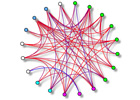
The results of this study can be represented as a network (as pictured above) in which each circle corresponds to a protein and each line represents a relationship.
To understand how a disease is initiated and progresses over time, proteins that behave abnormally need to be identified. Given that cells contain thousands of proteins, distinguishing between disease-causing and normal proteins is difficult. Dr. Igor Jurisica (PM Senior Scientist and Techna Core Lead) has developed a new computational method known as differential graphlet community that uses specialized networks to describe how proteins work together within a particular type of cell. Dr. Jurisica used the method to compare networks between healthy and cancerous lung tissue and identified several relationships between proteins that were expressed in cancerous tissue. These findings suggest that the differential graphlet community approach can be used to uncover new protein relationships that are involved in diseases and to identify new potential drug targets. [Pubmed abstract]

UHN was Canada's top research hospital in RE$EARCH Infosource's list of Top 40 Research Hospitals in Canada 2014. The list was part of their Canada's Innovation Leaders publication, which emphasizes the importance of hospitals in shaping Canada's research ecosystem. Since the inauguration of the list, UHN has remained the country's leader with research expenditures of $312 million for the 2013 fiscal year.
UHN researchers were included in a list of the world's most influential scientific minds of 2014. The list, prepared by Thomson Reuters, was created by analyzing researchers' citations—the number of times publications were referenced by peers—over an 11 year period. Researchers that ranked within the top 0.1% by citations in their field were included in the ranking. UHN scientists on the list were Drs. Igor Jurisica (PM Senior Scientist and Techna Core Lead), Anthony Lang (TWRI Senior Scientist), Andres Lozano (TWRI Senior Scientist; Affiliated Faculty, Techna) and Roger McIntyre (TWRI Clinical Researcher). Moreover, the four researchers were also included on Thomson Reuters' Highly Cited Researchers list.

UHN's Krembil Discovery Tower (KDT), which is home to one of Canada's most eminent neuroscience, vision and arthritis research programs, was named one of the 50 most beautiful University Hospitals in North America by the "Best Master of Science in Nursing Degrees" website. KDT's communal two-storey high collaboration centres and its sustainability features were acknowledged by the site. KDT was made possible by funds from several partners, including the Krembil family, the Canada Foundation for Innovation and the Toronto General & Western Hospital Foundation.

Dr. Pisters (right) with Katherine Sabo, TWH Executive Lead, during a visit to the Krembil Discovery Tower
UHN announced its new President and CEO, Dr. Peter Pisters, who will begin his role on January 1, 2015. He will bring with him a wide range of administrative and leadership experience from his current role at MD Anderson Cancer Center in Houston, Texas, where he is the Vice President, Regional Care System. Dr. Pisters is also an internationally renowned academic surgical oncologist with a specialty focus in sarcoma and gastrointestinal cancers.

This year, five UHN researchers successfully renewed their Tier 1 Canada Research Chairs, including Drs. Tak Mak (Chair in Inflammation Responses and Traumatic Injury), Linda Penn (Chair in Molecular Oncology), Benjamin Neel (Chair in Signal Transduction and Human Disease), Eleanor Fish (Chair in Women's Health and Immunobiology) and Gordon Keller (Chair in Embryonic Stem Cell Biology). Over the next seven years, these Chairs will provide $7 million to help support the innovative research programs of these world-leading scientists.
UHN secured $6.6 million from The Terry Fox Foundation. These funds will support the research of PM Senior Scientists Drs. Bradly Wouters and Robert Bristow to develop new and more personalized treatments that target the low oxygen levels in tumours.
UHN was awarded funding from Brain Canada, which announced that it will grant $10 million to support Phase III clinical trials for a new drug that may prevent damage due to stroke. The compound, known as NA-1, was developed by TWRI Senior Scientist Dr. Michael Tymianski. As part of this trial, paramedics will administer the drug to 518 stroke patients starting in 2015.
UHN secured funding from the Canada Foundation for Innovation to help create and expand state-of-the-art research facilities and programs in cancer, spinal cord injury, diabetes, cardiovascular, neurodegenerative and retinal diseases at UHN. Nine teams led by Drs. Peter Backx, Michael Fehlings, Housheng Hansen He, David Jaffray, Lakshmi Kotra, Tony Lam, Trevor Pugh, Valerie Wallace and Donald Weaver captured $4.8M through the John R. Evans Leaders Fund competition.
UHN's 2013 Research Report (Seeing Beyond: Achieving Health) received a Platinum Award in the 2012/13 League of American Communications Professionals Vision Awards Annual Report Competition. It was also ranked 1st within the Health Care Providers & Services class and 22nd out of the over 6,000 submissions—entries that hailed from more than 24 countries and 800 organizations around the globe.
The 2014 Research Report will be released soon. Titled Medicine Gets Personal, it will focus on how UHN's clinicians, scientists, staff and foundations are personalizing the delivery of health care.


 Dr.
Dr.  Dr.
Dr.  Dr.
Dr.  Dr. Paul Santerre, Techna's Director of Research Faculty (Physical Sciences), was the recipient of the prestigious 2014 Principal Award from the Ernest C. Manning Awards Foundation for his work on surface-modifying macromolecules. His invention, Endexo™ (commercialized through Interface Biologics Inc.), is an additive that helps to prevent blood clots from forming on plastic devices inserted into the body, such as catheters.
Dr. Paul Santerre, Techna's Director of Research Faculty (Physical Sciences), was the recipient of the prestigious 2014 Principal Award from the Ernest C. Manning Awards Foundation for his work on surface-modifying macromolecules. His invention, Endexo™ (commercialized through Interface Biologics Inc.), is an additive that helps to prevent blood clots from forming on plastic devices inserted into the body, such as catheters. The 2014 Association for the Study of Medical Education Gold Medal Award was presented to Dr.
The 2014 Association for the Study of Medical Education Gold Medal Award was presented to Dr.  Dr.
Dr.  Dr.
Dr.  Dr.
Dr.  Dr. Joanne Bargman received the 2014 Lifetime Achievement Award in Peritoneal Dialysis from the Annual Dialysis Conference. The award recognized Dr. Bargman's leadership and contributions to the field of peritoneal dialysis—an area that strives to improve the lives of those with severe chronic kidney disease.
Dr. Joanne Bargman received the 2014 Lifetime Achievement Award in Peritoneal Dialysis from the Annual Dialysis Conference. The award recognized Dr. Bargman's leadership and contributions to the field of peritoneal dialysis—an area that strives to improve the lives of those with severe chronic kidney disease. Dr.
Dr.  Dr.
Dr.  Dr.
Dr.